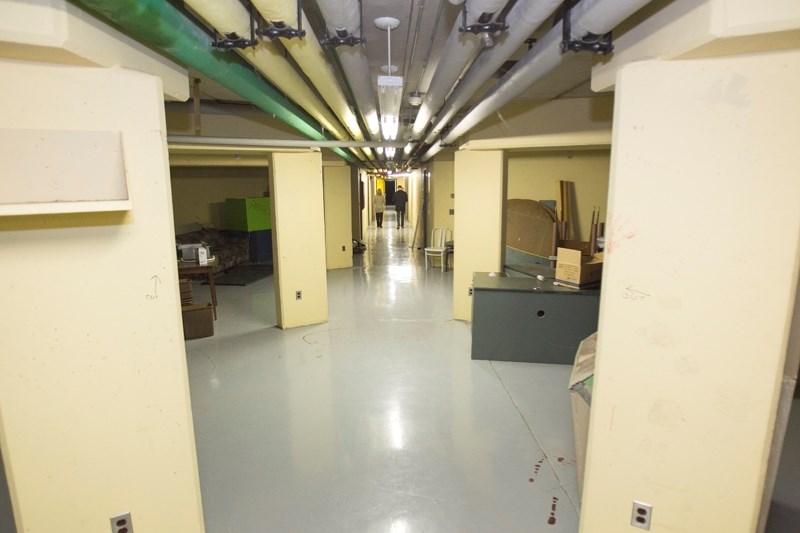Today, it's used mostly for storage.
Alcoves separated by sturdy, 30-degree-angle walls are filled with furniture and sports equipment.
There are windowless offices here and there and gooey fake blood is spattered on walls and floors from a recent Halloween party.
The only clues to its originally intended use are a stack of ancient mattresses piled in a corner, a sealed off canteen area, shower stalls with floors made up of wooden slats and a claustrophobic generator room.
This is the basement of Olds College's Frank Grisdale Hall residence, a concrete labyrinth beneath the dorm rooms and student lounges above.
And while in 2013 this basement is a depot of discarded refrigerators and crates of softballs, in 1968, when the residence opened, more than half of the basement was meant to serve as a sanctuary for Alberta's government should disaster have fallen upon the province.
“They built it for civil defence purposes to get the cabinet out of Edmonton if Canada was attacked,” said Garry McCullough, a former instructor at the college who lived in the residence from 1968 to 1970. “Because they were going to bomb Edmonton, don't you know.”
While a portion of the residence's basement housed student lounges, storage and offices for the college yearbook and newspaper, McCullough, who is also the curator of the college's alumni museum, said the bunker side of the basement, which he toured a number of times when he lived in the dorm, contained army bunk beds and “military-type” canned rations.
According to an article in the April 25, 1968, issue of the Olds Gazette about the opening of the residence, the “Emergency Measures Organization” shelter housed a communications centre, offices and equipment members of the government taking refuge could use.
“In the event of a disaster, EMO personnel from Calgary and other cities and towns in Southern Alberta will gather at the O.A.V.C. (Olds College) and carry out operations from there,” the article states.
Bob Clark, who served as the provincial education minister and the MLA for Olds-Didsbury at the time the shelter was completed, said he isn't sure whether he would have been ushered into the shelter if Alberta was the target of a nuclear attack or some other kind of catastrophe.
No one ever shared any plans with him about protocols for retreating to the shelter in such an emergency, he added.
Although he's not certain why Olds was chosen as the location of the shelter, Clark said the provincial public works and emergency measures departments decided the college's plan for a new residence could serve two functions: dormitories for students and a bunker for cabinet.
“One of the reasons that the student residence was built with so much cement and so much steel was the result of incorporating the two purposes,” he said.
One possible reason for the shelter coming to Olds, Clark said, was its proximity to Penhold.
“At the time, there was great concern about the Cold War and what was going on and the federal government, you may recall, had a bomb shelter for Alberta ministers in the federal government at Penhold,” he said. “In the eventuality that a very serious military event took place, it was common at that time for the provinces, and the federal government too, to have shelters where government could carry on and government could continue to function.”
Although it was not a secret that the shelter was located below the residence, its existence was “not well known” in the community and no mention of the shelter was made when the residence opened, Clark added.
While information on the shelter in local archives is scant, Wilson Redgwell, who served as the college's associate dean of men while the residence was being built in 1966 and 1967, said Olds was selected as a location for the facility for two reasons.
One, the town is located halfway between Alberta's two major cities and two, plans were underway in the community to build a large building that could house such a shelter.
Redgwell did tour the facility and he said each cubicle in the shelter had a red phone that was linked to other secured locations in Alberta and Canada and there was enough non-perishable food to last 100 people six months.
A diesel engine and generator supplied power to the shelter, he added.
When the threat of nuclear attack subsided, Redgwell said, part of the shelter was converted into a recreational area for students, although most of the original shelter area is locked off today.
The college is now in the first stages of building a new 450-unit residence to replace Frank Grisdale Hall and while college officials have said some of the residence's existing facilities may still be used once the new building is completed, the future of the hall, and the relic of Cold War history beneath it, are still up in the air.
Editor's note: The Olds Albertan thanks Connie Conley, the Community Learning Campus's corporate and client services director, and Jeffery Kearney, archivist at the Mountain View Museum and Archives for their assistance with this story.



